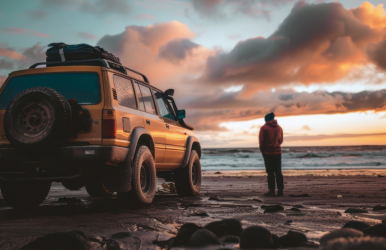Thinking Of A Fiji Cruise? Tips To Get You Started
BY Nabamita Sep 29, 2023
Australians and New Zealanders have learned to appreciate the pristine beaches, crystal-clear waters, and tropical adventures that the South Pacific has to offer. If you’re going on vacation, then look no further than the magical islands of Fiji because this destination has all the things that you need. See more about Australian-Fiji relations on this site here. Exotic birds, lush greenery, and refreshing beaches are just right on your doorstep, and it’s just a few days away from Brisbane or Sydney by ship. Explore these idyllic destinations at your own pace while enjoying the luxuries of a floating resort. However, before you set sail on this unforgettable journey, there are a few things to consider, and below are some valuable tips and insights to help you plan the perfect Fiji cruise experience. Whether it's choosing between small or large ships, or finding ways to save more on your voyage, below is some helpful information for you. Considerations for Your Fiji Cruise Year-round cruises are available, but the summer in Vanuatu, where it’s the most humid and hottest time is between November to March. Fiji temperatures can average between 26 to 31 degrees Celsius. Families with young children can be expected to be on board from December to January when the annual holidays are, so you might want to schedule your vacation when it’s not too busy. Itinerary Variety Islands in Fiji are more than 300, and only a hundred of them are inhabited. While it’s true that you can enjoy the resorts on each of them, you can only explore the rest by ship. Buying an exclusive yacht isn’t an option, but there are cruises in Fiji that can help you explore untouched destinations and off the beaten tracks. All of these can be done while you’re sleeping in comfortable cabins at night and waking up to a hot cup of coffee in the morning. Duration Choose among 12 or 17-night journeys and embark on either Auckland, New Zealand, or Sydney, Australia. This is going to give you enough time to visit popular ports like Mystery Island, Honolulu, Noumea, Suva, and Lautoka. Unwind in inhabited islands with underwater shipwrecks and beaches lined with coconut trees, or trek through the forest to feel the thunder of the Mele Cascades waterfall. Longer cruises often allow for more extensive exploration and give you ample time to immerse yourself in the beauty of Fiji, so don’t miss this opportunity. Activities and Excursions Snorkel at the beach and encounter sharks, and you can sail with the friendliest crew in Fiji. Small groups are guided by the crew and you’ll have the chance to feed the fish, get musical entertainment, view the turtles when in season, and get a delicious buffet lunch. Tribal face painting and fruit platters may also be onboard, depending on your chosen activities. Get a slice of paradise when you go into this ancient coral cay with its beautiful lagoon and surrounding fishes and experience the true meaning of tropical wonder. Onboard Amenities Are you looking for luxurious accommodations, fine dining options, or exciting entertainment choices? Sea-gazing is often the most popular, where the passengers have an obstructed view of the ocean in a glass-enclosed walkway. Others have slides that are not for the faint of heart, and other rides may also be available with splash areas that children can enjoy. Unique restaurants with affordable buffets or gourmets can also cater to your taste, so choose your ship well. Setting a Budget Basic room categories include the standard suites, balcony, and an outside view of the ocean. As you add more comfort, it becomes more expensive on the higher decks, where you can expect VIP access and exclusive amenities. Save money by going too early or late in the season and take a gamble with the weather. Look out for special deals or promotions that may help make your dream vacation more affordable. Small Ships vs Large Ships Cruisers may wonder about the difference in the size of the vessels when it comes to entertainment and dining choices. For those who don’t really mind the crowd, the best way to enjoy your luxury vacation in Fiji is through the big ships. It’s a big city where you can eat at different restaurants at night. There are endless possibilities where you can enjoy rope courses and see a lot of game shows and Broadway musicals. Rooms can be buzzing with extensive onboard activities such as pools, spas, casinos, and theatres, and there is never a dull moment in these floating resorts. They often feature spacious cabins with balconies for enjoying stunning ocean views, and you can read more about what to do at the ship at this link: https://www.escape.com.au/top-lists/top-tips-for-first-time-cruisers-11-things-ive-learnt-on-ships/image-gallery/c7a11bca07ecf3a65b7babf2d1d9da9a?page=1. Those who are on a honeymoon may prefer an intimate and personalized experience. With fewer passengers on board, you can expect more attentive service and the opportunity to form closer connections with both fellow travelers and crew members. The small groups also allow people to access remote locations that larger vessels cannot reach, giving you the chance to explore hidden gems and tropical havens. How to Save More on Your Cruise? As new ships are being built, the cruises are becoming more affordable as the years go by. With proper research, savvy spending, and adequate planning, you’ll have a trip that you can enjoy without breaking the bank. Here are some tips to help you out. High-demand cruise lines may publish a cheaper deal when they first sell their tickets, but there can be an increase as more people are buying them. When you have more flexibility, get an excellent deal around 90 days before the actual departure in Fiji and track the fares on various websites. Call an expert to see selections of staterooms and cabins. Booking through them can be helpful because they do most of the research for you, and they rarely charge extra for the knowledge. They also get specialized access to the sale price, which can save you money. Package deals that include flights, accommodations, and cruises all in one price are ideal, especially if you plan a lot of excursions while you’re in Fiji. These inclusions can sometimes provide better value than booking each component separately. Read Also: This Is The Best Time To Visit Iceland & These Are The Things You Should Do! Top 12 National Parks In Florida That You Must Visit Is Machu Picchu Closing In 2023? Know It All Here!













